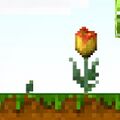Tulip: Difference between revisions
>Abcboy mNo edit summary |
>Danman0605 |
||
| Line 24: | Line 24: | ||
File:Tulip Garden.jpg|Assorted Tulips | File:Tulip Garden.jpg|Assorted Tulips | ||
File:Mature Tulip Stem.jpg|Mature Tulip | File:Mature Tulip Stem.jpg|Mature Tulip | ||
File:Young Tulip.jpg|Young Tulip | File:Young Tulip.jpg|Young Tulip | ||
File: Mature blue tulip.JPG|Mature blue tulip | |||
</gallery> | </gallery> | ||
[[Category:Item]] | [[Category:Item]] | ||
[[Category:Plant]] | [[Category:Plant]] | ||
Revision as of 17:02, 7 April 2015

A tulip is a plant that produces bulbs and seeds that was introduced in version 1.6.
Appearance
A young tulip is a small green stem with a shorter stem next to it. When fully mature, the tulip is still a somewhat short stem with two alternating leaves and at the top is a small flowering head that can be red, yellow, blue, or white and overall about one block tall. There are also hybrids colors which are combination of two colors (any of the four colors available) together.
Where Found
Tulips can be found growing in nearly all warm regions, including on floating islands.
Farming
Tulips are primarily used for the production and farming of tulip bulbs, producing both bulbs and seeds when harvested. Tulip bulbs and seeds can be planted in a block of dirt, sand, black sand, or compost to produce additional tulips and yielding more tulip products.
Harvesting for tulip products is achieved by hand or using a machete or spade on a mature tulip. Using an appropriate tool will approximately double the yield results over hand harvesting. If a mature tulip goes unharvested, the plant will turn into a young tulip to begin a new life cycle but not generate any drops.
Notes
Tulip bulbs, when planted, will grow a genetically identical copy of the parent tulip. Tulip seeds will grow into a different tulip, where both inter-breeding and mutation play a role.
Trivia
Currently, there are around 75 wild species of tulips and 150 species in total with over 3,000 varieties.
Gallery
-
Assorted Tulips
-
Mature Tulip
-
Young Tulip
-
Mature blue tulip




